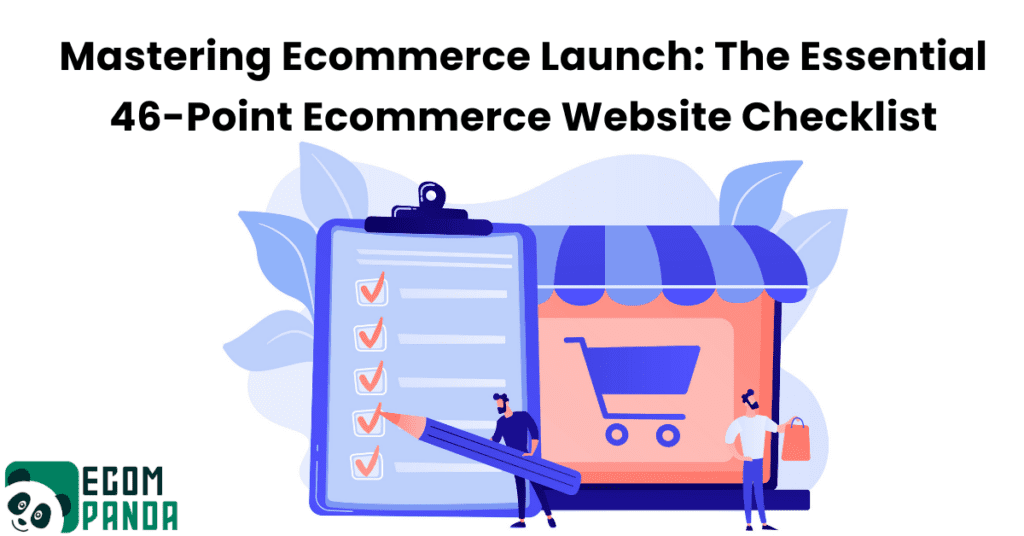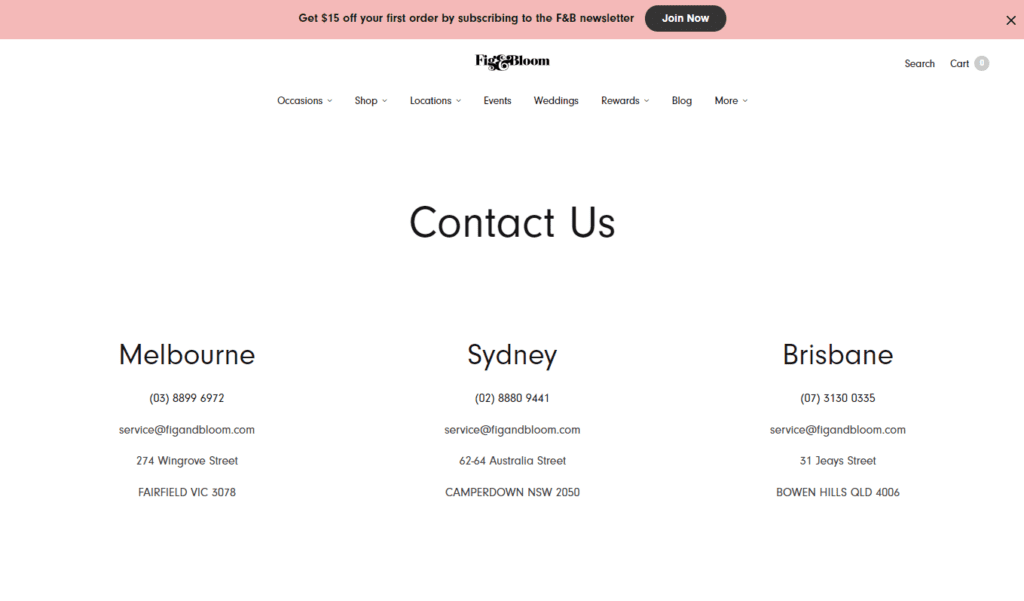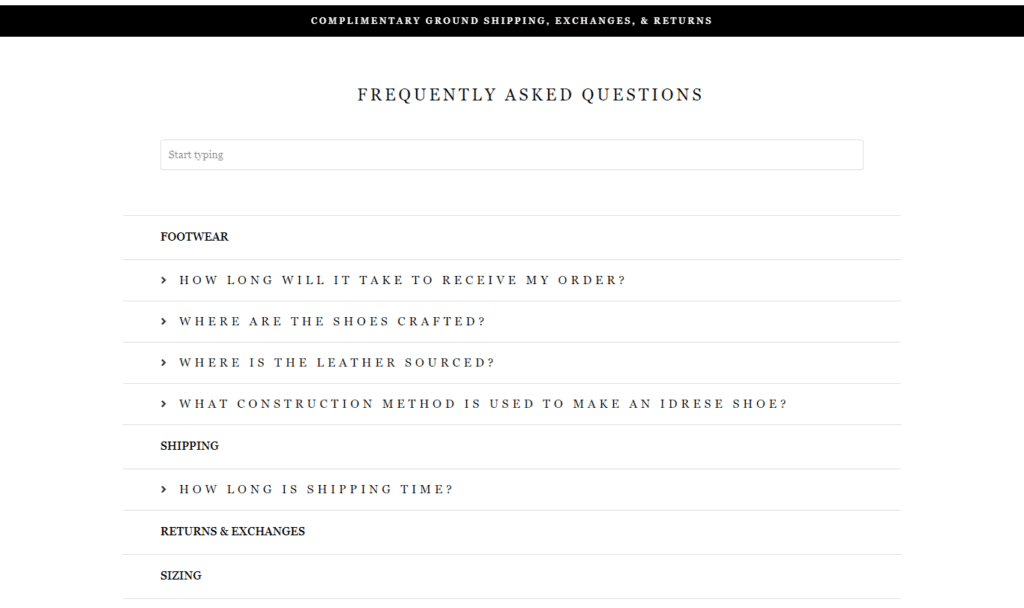Introduction
As we march on into a digital-first age, ecommerce has taken center stage in the world of retail. Whether you’re a traditional brick-and-mortar store eyeing an online debut or a startup ready to dive headfirst into the online market, preparation for your ecommerce launch is crucial.
With 69.8% of shopping carts being abandoned on ecommerce platforms according to Baymard Institute, you’ll want to make sure you’re not part of the statistics. This can only be achieved through meticulous planning and a detailed ecommerce website checklist.

Table of Contents
The Importance of Preparation for Ecommerce Launch
An ecommerce launch is a significant venture. It isn’t just about creating an online platform and adding your products. It’s about creating an experience for your customers that is seamless, engaging, and above all, trustworthy. Given the high cart abandonment rates, one of the significant steps to avoid falling into this trap is ensuring you’re fully prepared before launch.
Preparation is not merely about getting your products and services online. It’s about understanding the digital marketplace, knowing your competition, having a clear idea of your target audience, and ensuring your website is functional, easy to navigate, and visually appealing. A comprehensive ecommerce website checklist helps you keep track of these essential aspects, making sure you’ve covered every base before going live.
Furthermore, preparation is also about creating a robust digital marketing strategy. Search Engine Optimization (SEO) is a critical part of this. By adhering to the latest Google algorithms, your ecommerce platform can gain better visibility, driving more traffic to your site. This further highlights the importance of an ecommerce website checklist.
How to Use this Checklist
This ecommerce website checklist is a tool designed to guide you through the journey of launching your ecommerce platform. It consists of various elements, including technical considerations, design aspects, content requirements, SEO factors, and more. To use this ecommerce website development checklist effectively, we recommend the following steps:
- Understand the Checklist: Before diving into the items, ensure you understand what each point entails. This way, you can align the checklist with your business objectives effectively.
- Delegate the Tasks: If you’re working with a team, delegate each point in the checklist to the appropriate team member or department. This allows for efficient execution and accountability.
- Follow the Order: While it may be tempting to skip around, it’s beneficial to follow the ecommerce website checklist in the order provided. This sequence has been strategically designed to make the process as smooth as possible.
- Track Progress: As you complete each task, tick it off the list. This will give you a clear visual representation of what you’ve accomplished and what still needs to be done.
- Revisit Often: The ecommerce website checklist isn’t a one-time tool. It’s a document you should revisit often to ensure you stay on track and adapt to any changes that may occur in your business or the ecommerce landscape.
Remember, each point on your ecommerce website checklist represents a crucial aspect of your online store. Neglecting any single point could potentially lead to less traffic, lower conversion rates, and ultimately, a dip in sales.
In the world of ecommerce, preparation is king. Make sure you’re well equipped with your ecommerce website checklist to ensure a successful launch. The world of online retail is waiting for you. Happy selling!
Ecommerce Website Checklist: Things You Must Consider
Before You Start
Before you start your journey into the world of online business, it is essential to have a well-structured ecommerce website checklist. This checklist should guide you through the crucial steps required to set up a successful ecommerce website, ensuring that you don’t miss any vital aspects.
Have a Custom Domain
The first step in your ecommerce website checklist involves having a custom domain. Operating under something generic like “storename.myshopify.com” could limit your brand’s credibility and professionalism.
Choose a domain that resonates with your brand and offers a sense of trustworthiness to your potential customers. Domain names are usually available at a relatively low yearly fee and are a small price to pay for establishing a professional image.
Set Up Email Forwarding
Your ecommerce website checklist should also include setting up email forwarding. A professional email linked to your domain not only fosters a sense of trust but also establishes a consistent line of communication with your customers. Email forwarding allows you to receive customer emails in your personal inbox, maintaining a professional appearance without the hassle of managing multiple accounts.
Establish an Email Helpdesk
An email helpdesk is essential in managing and organizing your support emails, making it a crucial part of your ecommerce website checklist. Set up an email like “[email protected]” and forward it to your helpdesk email to streamline your customer support operations.
Activate Sales Channels
Many ecommerce businesses leverage social media channels and blogs to sell their products. Make sure to include activation of the proper sales channels in your ecommerce website checklist. Review options like Pinterest Buyable Pins, Facebook Shop tabs, Instagram Shoppable Posts, Twitter Buy Buttons, and the Buy Button for your WordPress blog to maximize your success.
Choosing the Right Ecommerce Platform
The choice of the right ecommerce platform is a pivotal part of your ecommerce website checklist. Platforms like BigCommerce, Shopify, or WooCommerce have their unique features, strengths, and limitations. Consider the requirements of your business before selecting the platform.
Competitor Website Design, Content & Offers Review
Next in your ecommerce website checklist is understanding your competition. Scrutinize your competitors’ website design, content, and offers. This step allows you to gather insights about what works and what doesn’t within your niche, informing your strategies.
Developing Your Core Branding & Logo
Your ecommerce website checklist should prioritize branding. A strong, coherent brand, including a memorable logo, helps distinguish your business from competitors and create a solid connection with customers.
Planning/Drafting Key Messages / Sales Content
Well-crafted key messages and sales content play a critical role in converting visitors to customers. Therefore, your ecommerce website checklist should include planning and drafting these crucial pieces of content.
Keyword & Content Ideas to Reach Your Target Audience
To ensure your ecommerce website reaches your target audience, include keyword research and content ideation in your ecommerce website checklist. These elements are critical to improving your site’s SEO and drawing in potential customers.
Product Samples and Final Logistics Plan
Before launching, it’s crucial to obtain product samples and finalize your logistics plan. This can ensure the quality of your products and the smooth operation of your delivery process.
High-Quality Product and Lifestyle Images Acquisition
Finally, your ecommerce website checklist should include acquiring high-quality product and lifestyle images. Professional, engaging images can significantly impact your customers’ perception and experience, ultimately influencing their purchase decisions.
The ecommerce website checklist is a powerful tool to navigate the complex process of setting up an online business. By following this checklist, you can ensure a smooth and successful ecommerce website launch, and lay the groundwork for your business’s growth and success.
Website Design
Website design is a crucial aspect of building an online presence, particularly for ecommerce businesses. As part of an ecommerce website checklist, understanding and implementing some vital design considerations is crucial to create a site that is visually appealing, user-friendly, and most importantly, drives conversions.
Design Considerations
The three essential design considerations for an ecommerce website include branding and color consistency, clear calls to action, and the use of high-quality images. These factors can significantly affect the site’s aesthetics, usability, and overall user experience.
- Branding and Color Consistency
Branding is vital for an ecommerce business to establish its identity, and this should reflect in the website design. The website should portray the brand’s personality, mission, and values. Consistency in color, typography, logo, and other visual elements across the site helps in strengthening brand recognition.
Consistency forms the first checkpoint in the ecommerce website checklist, contributing to an engaging and coherent user experience. Implementing brand colors and graphics consistently across the website also makes the site visually appealing and memorable.
- Clear Calls to Action
Having clear calls to action (CTAs) is an important consideration in website design. These prompt users to take a specific action, such as ‘Buy Now’, ‘Add to Cart’, ‘Sign Up’, or ‘Learn More’. CTAs should be visually prominent and placed strategically to lead users through the conversion funnel. As part of the ecommerce website checklist, using persuasive and action-oriented language in CTAs can significantly improve conversion rates.
- High-Quality Images
The third crucial point in the ecommerce website checklist is the use of high-quality images. As online shoppers cannot physically inspect products, high-resolution images and videos are essential to provide a detailed view. Images should accurately represent the product, and it’s advantageous to include different angles and in-context uses.
Furthermore, using aesthetically pleasing and engaging images can help attract and retain users’ attention, contributing to a better user experience and increased sales.
However, while high-quality images are critical, they need to be optimized for web use to ensure they don’t affect the website’s loading speed, a key factor in retaining user interest and improving SEO ranking.
A well-designed website is a powerful tool for ecommerce businesses. It’s not only about creating a visually pleasing site but also about constructing an effective platform for user interaction and conversion. By adhering to this ecommerce website checklist and prioritizing these design considerations, businesses can create a website that stands out, engages users, and most importantly, drives sales.
In the digital age, an ecommerce website is more than a sales platform; it’s a critical representation of your brand and an essential part of your marketing strategy. Effective website design with clear branding, clear CTAs, and high-quality images is key to ensuring a high conversion rate and business success.
Incorporating these key design considerations in your ecommerce website checklist ensures an engaging, user-friendly, and successful website. It is imperative to routinely review these considerations, adjusting the design elements as necessary to maintain a high-performing ecommerce site that keeps pace with evolving user preferences and technological advancements.
- Accessible Cart and Checkout Pages
A crucial step in our ecommerce website checklist is ensuring accessible cart and checkout pages. A properly optimized checkout page plays a key role in customer retention and revenue growth.
Therefore, to minimize cart abandonment rates, you need to address key elements such as complex checkout steps, hidden charges, security doubts, and lack of payment or shipping options.
For example, allowing guest checkouts can dramatically reduce the barrier for potential customers.
Additionally, showcasing product attributes in the cart can reassure customers that they’ve selected the right products, reducing the chance of abandoning the cart.

- Grabbing Attention
The next item on our ecommerce website checklist is grabbing the customer’s attention. The first step to grabbing attention is by making sure the checkout page is straightforward and distraction-free.
For example, removing unnecessary headers and footers can keep the customer focused on completing their purchase. The use of smart form filling, such as auto-fill options, can also make the checkout process smoother, thereby retaining the customer’s attention.
- The Role of Favicon
The favicon might seem insignificant, but it plays a vital role in the ecommerce website checklist. A favicon adds an extra level of professionalism and brand identity to your website. It helps in enhancing brand recognition among consumers, which in turn could positively impact their purchasing decision. The favicon can also assist users in quickly identifying your website when multiple tabs are open in a browser.
- Effective Product Display
Our ecommerce website checklist wouldn’t be complete without addressing effective product display. Providing clear and detailed product information is vital to drive customers towards purchase. It’s beneficial to show product attributes in the cart, such as fabric, finish, and size, to reassure users about their selection.
Additionally, using high-quality images and videos, as well as interactive elements such as 360-degree views or zoom-in capabilities, can give customers a better understanding of what they’re buying, ultimately leading to lower cart abandonment rates.
- Retina Version of Your Logo
Finally, the last item in our ecommerce website checklist is about the retina version of your logo. In today’s digital world, customers are likely to use devices with varying screen resolutions, including high-resolution retina displays.
A retina logo ensures your brand appears sharp and professional on all devices. Having a blurry or pixelated logo can damage your brand’s reputation and potentially deter customers. So, it’s crucial to provide a high-resolution, retina-ready version of your logo to ensure it looks good on any device.
Therefore, optimizing your ecommerce website according to this checklist can significantly improve your customer’s shopping experience, leading to increased conversions and lower cart abandonment rates. Remember that every detail, no matter how small it may seem, contributes to the overall user experience and can have a significant impact on your business’s success.
Homepage Design
When designing a homepage for your e-commerce platform, it’s vital to follow a comprehensive ecommerce website checklist to ensure optimal usability and functionality, guaranteeing a smooth user experience that encourages conversions and customer loyalty.
Your checklist should encompass aspects such as logo design, browser and device compatibility, promotion graphics and links, and popular product links, among other key elements.
Designing Logo
The logo is an essential part of your brand identity and plays a significant role in your ecommerce website checklist. It needs to be unique, recognizable, and representative of your business values and products.
A good logo design can help establish trust and make your online store memorable. Moreover, the logo should be prominently placed on your homepage and linked to it, providing a way for visitors to easily navigate back to the homepage from any page on your website.
Ensuring Compatibility with All Browsers and Devices
Another crucial aspect of your ecommerce website checklist is ensuring your homepage is compatible with all browsers and devices. In today’s digital world, consumers use a variety of browsers and devices, such as desktops, tablets, and smartphones, to shop online.
To create an inclusive shopping environment, your website should be responsive and adaptable, offering a seamless shopping experience regardless of the user’s device or browser.
Maintaining ecommerce website testing checklist and updating your website for compatibility is vital.
Promotion Graphics and Links
Promotion graphics and links form an integral part of your ecommerce website checklist. They can grab the attention of visitors, guide them towards your special deals or new product lines, and significantly boost your sales.
These graphics should be eye-catching, relevant, and updated frequently to reflect your latest offerings. However, it’s crucial to ensure they don’t overwhelm or confuse your customers. Clear and concise call-to-action statements can help visitors understand what action you want them to take.
Popular Products Links
Including popular product links on your homepage is another crucial element of your ecommerce website checklist. Displaying your top-selling products on the homepage can encourage visitors to explore and make a purchase, thereby improving your conversion rates.
It’s also an excellent way to show first-time visitors what other customers are buying, which can help establish trust and credibility.
However, these products should be regularly updated to reflect current trends and customer preferences.
The ecommerce website checklist is a comprehensive guide that ensures your website is optimized for user experience, functionality, and sales conversion. It includes vital aspects such as logo design, compatibility with all browsers and devices, promotion graphics and links, and popular product links.
Regularly revisiting and updating this checklist is key to the success of your online store. If executed correctly, these components can significantly boost your site’s performance, improve customer satisfaction, and ultimately drive your business growth.
While constructing an ecommerce website, several factors are pivotal to ensure it captivates, engages, and retains the interest of the customer.
Within this context, three essential aspects from the ecommerce website checklist, namely, calls to action (CTAs), display of special promotions, free shipping options, and updating latest company/industry news, deserve specific attention.
Calls to Action
When it comes to CTAs on an ecommerce site, they are not just simple buttons or links but powerful tools that guide users towards desired objectives such as making a purchase, subscribing to newsletters, or sharing product details. Consequently, CTAs should be clear, compelling, and contextually placed.
Using verbs that provoke emotion or enthusiasm, such as ‘Get it now!’ or ‘Claim your free trial!’, can improve engagement rates. By adopting a color for your CTAs that contrasts with the website’s overall color scheme, you enhance their visibility and thus effectiveness.
Furthermore, the CTA’s placement is crucial; prominent positions can significantly improve the likelihood of user engagement.
Special Promotions and Free Shipping Options Display
The second point on our ecommerce website checklist is the display of special promotions and free shipping options. Studies show that free shipping is one of the most enticing incentives for online shoppers, often being a determinant factor in the purchase decision. Displaying these options prominently on your site can significantly increase conversion rates.
Similarly, special promotions, discounts, and deals, attractively presented, can have a substantial influence on a customer’s purchasing decision. Websites can highlight these elements on the homepage, product pages, or even as pop-ups.
Moreover, creating a dedicated page or section for deals can be beneficial. Visitors who are deal-hunters can navigate to this page and be converted into customers. The placement of these promotions and free shipping options must be strategic to garner maximum visibility, such as the header, footer, or a slide-in sidebar.
Latest Company/Industry News Area
The final element of the ecommerce website checklist is keeping customers informed about the latest company or industry news. This could include updates about new products, changes in policies, industry trends, events, or achievements. By incorporating a news area into your site, you can improve customer engagement, demonstrate transparency, and establish your brand as a thought leader in your sector.
You can create a blog section, news ticker, or RSS feed for this purpose. However, it’s crucial to regularly update this section to ensure the content remains relevant and interesting to the site’s visitors.
While these three elements are vital, they should be incorporated as part of a broader ecommerce website checklist to ensure that your site is optimized in its entirety. Keep in mind that the ecommerce world is dynamic, and customer preferences change over time. Therefore, regular review and updates of your website based on comprehensive ecommerce website checklists are recommended to keep up with changing trends and demands.
When setting up an ecommerce store, there are many elements to consider to ensure optimal user experience and seamless transactions. A couple of these integral features include links to recent purchases and popular products, and the provision of a store finder and language options if necessary.
With that in mind, I’m going to delve deeper into these aspects and incorporate them into our ecommerce website checklist.
Links to Recent Purchases and Popular Products
Links to recent purchases and popular products can significantly enhance user experience on an ecommerce website. These features provide shoppers with a window into what others are buying, which can in turn influence their own purchasing decisions.
Firstly, displaying recent purchases offers the dual benefit of building trust and encouraging shoppers to make a purchase. When customers see that other people are actively buying, it alleviates any uncertainties they may have about the credibility of the store and the quality of its products.
Secondly, showcasing popular products can act as an automated recommendation system. This feature can draw attention to products that are frequently purchased by other customers, giving shoppers a quick view of what items might be worth considering. By presenting your visitors with the ‘best sellers,’ it can aid in their decision-making process and expedite their path to purchase.
Incorporating links to recent purchases and popular products in our ecommerce website checklist is therefore paramount. Not only does it improve the user experience, but it also serves as a subtle yet effective marketing tool.
Store Finder & Language Options If Necessary
Depending on the scale of the business and the demographics of the target audience, implementing a store finder and language options can significantly enhance the accessibility of an ecommerce website.
A store finder is especially crucial for ecommerce businesses that also operate brick-and-mortar stores. This feature enables customers to locate physical stores nearest to them, providing them with more shopping options. Additionally, if your online store offers click-and-collect or in-store return services, a store finder is absolutely necessary.
Language options are vital for businesses operating in multiple regions or countries. Offering content in various languages expands your potential customer base and ensures that your products and services are accessible to a wider audience. Providing language options showcases your commitment to serving customers from diverse backgrounds, which could foster a more inclusive brand image.
Our ecommerce website checklist is a dynamic and comprehensive tool that encompasses all the vital features required for an efficient online store. These include offering links to recent purchases and popular products, and providing a store finder and language options if necessary.
By integrating these elements, you can create an ecommerce platform that delivers a seamless shopping experience, fosters customer trust, and ultimately, drives sales.
Standard Website Pages
As part of your ecommerce website checklist, one of the crucial factors you need to consider is the structure and design of your standard website pages. These pages include the About Us page, the Contact Us page, and the Frequently Asked Questions (FAQ) page.
About Page
The About Us page on an ecommerce site plays a pivotal role in building trust with potential customers. It’s your chance to tell your company’s story, convey your brand values, and present your mission.
You can communicate how your brand began, why it exists, and what makes it unique. It helps establish a connection with your audience and inspire them to choose you over your competitors. Hence, an appealing and engaging About Us page should be on your ecommerce website checklist.
Remember, people tend to buy from brands they can relate to, so let your personality shine through in your About Us page. Include images, graphics, or videos to bring your story to life. It’s also essential to keep this page updated as your business evolves.
Contact Us Page
Your Contact Us page is another critical part of your ecommerce website checklist. It provides your customers with different ways to get in touch with you, which helps to build trust and improve your customer service.
This page typically includes your physical address (if applicable), phone number, email address, and possibly a contact form. It’s also helpful to include your operating hours and expected response times so customers know when they can expect a response. Having clear and easy-to-find contact information can ease customer concerns and potentially increase conversions.
You can also add links to your social media profiles and other relevant information such as the location of your stores if you have a physical presence. Remember, a good Contact Us page isn’t just about listing your contact details, but about making your customers feel welcome to reach out.

FAQ (Frequently Asked Questions) Page
A well-constructed FAQ page is another must-have on your ecommerce website checklist. It provides answers to the most common questions your customers might have, which saves them time and improves their shopping experience.
The FAQ page can cover topics like shipping, returns, product usage, and any other information your customers frequently request. Remember to organize the questions logically and make the page easy to navigate.
It’s also beneficial to update your FAQ page as new common questions emerge. This will reduce the volume of queries that reach your customer service team, allowing them to focus on more complex issues. Plus, an updated FAQ page can act as a useful resource for your customers, contributing to a better overall customer experience.
These three standard pages (About Us, Contact Us, and FAQ) are essential components of a successful ecommerce site and should be high on your ecommerce website checklist.
They can play a significant role in building trust with your customers, clarifying important information, and improving the overall customer experience. So, ensure you spend ample time crafting these pages with the necessary attention to detail.

Website Functionality
Website functionality is the cornerstone of a good user experience. It doesn’t matter how good your website looks if it’s not working as expected. To ensure a smooth experience, it’s crucial to include specific elements in your ecommerce website checklist, such as links validation and forms testing.
Links Validation
Link validation is an essential part of the ecommerce website checklist. Broken links can lead to a poor user experience, which could potentially deter visitors from returning to your site. A 404 page is not only frustrating for the user, but it can also hurt your SEO rankings.
To ensure all links on your website are functioning properly, manually click on each link to confirm they’re leading to the correct pages. Don’t forget to test links in your header, footer, CTAs, product pages, and any links included in blog posts or articles. Automated link checker tools can also help you find broken links across your site.
Forms Testing
Forms testing is another crucial component of the ecommerce website checklist. Many websites will have forms that visitors need to fill out, whether it’s for signing up for a newsletter, creating an account, or making a purchase. These forms need to function properly to ensure a smooth user experience.
It’s necessary to test the configuration of your forms to verify inputs, field validation, and overall functionality. For example, a “Name” field should not allow users to enter numbers, and “Required” fields should be marked as such.
Also, consider what happens when there are invalid inputs. Does the user receive a message informing them what’s wrong? This testing can ensure that the form collects all the necessary data and that the data is in the proper format.
Additionally, the form submission process should also be tested. Check that forms are being submitted properly and that any associated automatic emails or notifications are being sent out correctly.
Including link validation and forms testing in your ecommerce website checklist is a great way to uncover mistakes, bugs, or oversights that might have been missed during the website development and design phases. Remember, a seamless user experience can significantly impact the success of your ecommerce website.
Finalizing Website Setup
After creating your website’s structure, selecting an eCommerce platform, and curating your product listings, the final stage in the eCommerce website checklist involves securing a custom domain and installing essential apps.
Secure A Custom Domain
A custom domain is crucial for any eCommerce website. It gives your business a professional image, improves search engine ranking, and aligns with your brand identity. When customers see a custom domain, they are more likely to trust your site and make a purchase.
Securing a custom domain can be done in several ways. One common method is through your eCommerce platform. For instance, platforms like Shopify or BigCommerce offer domain registration services as part of their packages.
Alternatively, you can use a separate domain name registrar. Ensure the domain you choose is concise, easy to remember, and reflects your business name or the products you sell.

Install Essential Apps
The second part of our eCommerce website checklist focuses on the installation of essential apps. These apps enhance your site’s functionality, optimize your operations, and improve the overall user experience. The specific apps you choose will depend on your business needs and the platform you’re using. However, some categories are nearly universal in their utility.
Firstly, consider installing SEO tools. These will help your site rank better in search engines, thereby increasing your visibility and attracting more potential customers. Also, consider apps that facilitate product reviews. This enables customers to share their experiences, thereby promoting trust and driving sales.
Next, ensure you have a robust analytics tool. This is crucial for understanding your customer behavior, tracking sales, and making data-driven decisions.
Lastly, consider installing apps for email marketing and social media integration. These tools will aid in your marketing efforts, helping you build a strong relationship with customers and promote your products on various platforms.
To round off this section of the ecommerce website checklist, always remember to update your apps regularly and explore new tools that could boost your site’s performance and the customer experience.
Securing a custom domain and installing essential apps are crucial steps in finalizing your website setup. They enhance your site’s professionalism, improve its functionality, and ultimately lead to an increased customer base and higher sales.
Set Up Email Forwarding
Setting up email forwarding for your ecommerce website is an essential item on your ecommerce website checklist, allowing you to direct messages sent to your custom domain email address to another email address. This service, offered by Shopify, enables the setup of an unlimited number of custom domain email addresses that forward to an email account hosted by a third-party.
For instance, if you own the domain name my-ecommerce-website.com, you could create the custom domain email address [email protected] and set the forwarding email address to your personal account [email protected]. As a result, when customers send emails to [email protected], the email messages are forwarded to your existing personal account.
Here are the steps to set it up:
- From your Shopify admin, navigate to Settings > Domains.
- Click the domain for which you want to set up a custom email forwarding address.
- In the Email forwarding section, click Add forwarding email.
- In the Forwarding email address field, enter the email address that you want to create for your custom domain. For instance, if you want the email address [email protected], enter ‘info’.
- In the Receiving email address field, enter your full destination email forwarding address, for instance, [email protected].
- Click Save.
To help ensure that email messages are forwarded successfully, you should add a Sender Policy Framework (SPF) record to your Shopify-managed domain. This step might require some technical knowledge, so you may need to seek help from a tech-savvy individual or a professional if you are not familiar with DNS settings.
Customize Theme Design
The design of your ecommerce website can significantly influence your brand’s image and customers’ shopping experience. It’s another crucial item on your ecommerce website checklist, and Shopify provides a wide range of free and paid themes that can be customized to match your business style and needs.
Here’s how you can customize your theme:
- From your Shopify admin, navigate to Online Store > Themes.
- In the Free themes section near the bottom of the page, click Explore free themes to view available themes.
- Click any theme to read about its features and to preview the available theme styles.
- Click the Add button for the theme that you’ve chosen. The theme will be added to the Themes page of your admin.
You can also buy a paid theme from the Shopify Theme Store if you’re looking for a more unique design. Paid themes are developed by third-party designers, and help with customizations for these themes is provided by the theme designer. Be sure to preview any paid themes before buying to ensure it suits your needs.
Completing these tasks should be a high priority on your ecommerce website checklist. They will help streamline your email communications and ensure your website provides a pleasant browsing experience, thus contributing to your overall ecommerce success.

Post-Launch Activities
After the launch of your eCommerce website, it’s not the end but just the beginning of a new journey. This part of the eCommerce website checklist includes crucial activities that ensure the success of your website.
Monitoring User Behavior
Just like the heart monitor in a hospital, your website needs consistent monitoring to keep its pulse. Using tools such as Google Analytics, you can keep track of the user behavior on your website, analyzing metrics such as bounce rate, average time on page, and conversion rates. By understanding how users are interacting with your website, you can identify any issues or opportunities for improvement, making it a significant part of the eCommerce website checklist.
For instance, if you notice that users are leaving a particular page without interacting, it could indicate that the page isn’t engaging or lacks the necessary information. On the other hand, if a product page has a high conversion rate, you may want to investigate what makes that page effective and apply similar strategies to other product pages.

Regular Website and SEO Optimization
While monitoring user behavior provides valuable insights, these insights must be put into action through regular website and SEO optimization. This is another crucial step in the eCommerce website checklist.
Your website should be regularly updated with new content, while also ensuring that old content remains relevant and accurate. This not only keeps your website fresh and engaging for returning visitors but also signals to search engines that your website is active, potentially improving your search engine rankings.
SEO optimization should be an ongoing effort. Regularly audit your website for SEO errors and issues, such as broken links, missing meta descriptions, or pages not indexed by search engines. As the algorithms of search engines are always evolving, staying on top of the latest SEO trends and applying them to your website can help maintain or improve your visibility in search engine results.
Moreover, remember to keep track of the technical health of your website. Regularly back up your data, ensure that your SSL certificate is working properly, and keep your CMS up-to-date. Make sure that your site navigation is user-friendly and all links are working as expected.
In a nutshell, the eCommerce website checklist doesn’t end at the launch of the website. Continuous monitoring of user behavior and regular website and SEO optimization are key to the long-term success of your eCommerce website. This ongoing effort will ensure that your website remains relevant, engaging, and efficient in converting visitors into customers.

Conclusion
In conclusion, the utility of an ecommerce website checklist in building a successful online store cannot be overstated. It’s essential to remember that it serves as a systematic guide, helping ensure that every necessary aspect of an ecommerce venture is well accounted for and implemented.
Key Takeaways
No doubt, website checklist helps in eliminating the chances of missing any critical steps in the process of setting up an online store. Thus, the ecommerce website checklist plays a crucial role in launching a successful ecommerce store.
The ecommerce website checklist is an invaluable resource for business owners embarking on their ecommerce journey. It assists in answering the numerous questions that tend to arise when setting up an online store.
These may range from theme selection, image placement, cart icon position, to setting up a payment gateway, among other factors. Such a checklist, therefore, helps overcome any sense of overwhelm and prepares aspiring entrepreneurs for the multiple steps they need to take.
Moreover, having an ecommerce website checklist serves as a roadmap, guiding the user towards the creation of an efficient and user-friendly online store. A comprehensive checklist includes sections on setting up the homepage, ensuring compatibility across various devices and browsers, placing promotional graphics, and links to popular products, among others.
It even reminds you to create important elements like a search field, display of specials, promotions, or shipping options, and areas for latest company news or popular brands.
The ecommerce website checklist also ensures the development of other crucial web pages beyond the homepage. These pages contribute towards a seamless user experience, and include ‘About Us’ pages to share your company’s story and values, ‘Contact Us’ pages for effective customer communication, and ‘FAQ’ pages to address common customer queries.
The checklist may even remind you to establish a transparent ‘Terms of Service’ and a customer-centric ‘Privacy Policy’.
Final Thoughts
Overall, the ecommerce website checklist plays an irreplaceable role in ecommerce ventures. It aids in mitigating confusion, simplifying the process, and optimizing the efficiency of setting up an online store, ensuring that entrepreneurs don’t miss out on any critical components. As the landscape of eCommerce continues to evolve, checklists will only become more integral to ensuring a smooth and successful store launch. The ecommerce website checklist is not just a guide, but a proven path to ecommerce success.
Frequently Asked Questions
What is an eCommerce checklist?
An eCommerce checklist or eCommerce website checklist refers to a list of action steps required for successfully launching an online store. It includes things such as securing a custom domain, setting up email forwarding, activating sales channels, and many more. The checklist aims to ensure all critical processes are addressed, and no step is overlooked in the course of the launch.
What should be included in an eCommerce website?
An eCommerce website should include a custom domain to enhance brand recognition, standard pages such as the home page, about page, contact page, FAQ page, terms of service, and privacy policy. These pages provide necessary information about the business, its purpose, history, and how customers can get in touch. An effective eCommerce website also needs to ensure smooth functionality and clear navigation to browse other pages.
What top 10 features are a must for any e-commerce site?
The top 10 features of an eCommerce website, based on the eCommerce website checklist provided, would include;
- a custom domain
- email forwarding
- activated sales channels
- an email helpdesk
- high-quality product images
- a choice of a reliable eCommerce platform
- well-researched keywords
- competitive analysis
- brand logo
- effective sales content.
What is an ecommerce assessment?
An eCommerce assessment, also known as eCommerce testing or evaluation, involves analyzing various elements of your website, like its design, pages, functionality, and features to determine its performance and overall success. It helps increase user engagement, develop effective marketing strategies, enhance conversion rates, generate more sales and revenue, and identify potential site issues.
What is an e-commerce tool?
An eCommerce tool refers to any software, platform, or application that helps businesses execute their operations more effectively and efficiently. They include eCommerce platforms like Shopify, BigCommerce, or WooCommerce, email helpdesk solutions, SEO tools, analytics platforms, social media sales channels, and more. These tools aid in various functions from managing the store, communicating with customers, to tracking performance.







